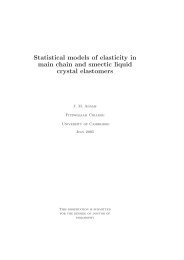Sandra Hopkins Final Report.pdf - University of Surrey
Sandra Hopkins Final Report.pdf - University of Surrey
Sandra Hopkins Final Report.pdf - University of Surrey
Create successful ePaper yourself
Turn your PDF publications into a flip-book with our unique Google optimized e-Paper software.
Firstly a free in air measurement with no additional copper filters in the beam. The calibration wasfound to be within 8% to 15%. The accuracy <strong>of</strong> this measurement is affected by the fact that highexposure factors are needed to get a high enough dose rate to provide sufficient accuracy. It wasalso found that the indicated dose rate was not always stable despite the exposure factors remainingstable. There was a larger difference between measured and indicated skin dose with Copper in thebeam path. However, the calibration was still inside the manufacturers tolerance and wasconsidered sufficiently accurate for the current work.Additional measurements <strong>of</strong> skin dose with Perspex in the beam to simulate the patientdemonstrated that the calibration was still satisfactory. It was expected that the radiation backscattered from the Perspex would increase the dose to the ion chamber and lead to a closercorrelation. However, this increase appears to be <strong>of</strong>fset by the reduction in dose to the ion chamberdue to the table attenuation. This implies that calibration <strong>of</strong> the skin dose indicator can be checkedwith sufficient confidence with either the free in air method or with scattering media on the table.The final method for measuring skin dose was with the use <strong>of</strong> thermoluminescent dosimeters(TLDs). Whereas the skin dose indicator appeared to over read when compared to the ion chamber,the indicated skin dose indicator now appeared to under read by 26% to 33%. This is a highlysignificant difference. TLD measurements positioned outside the direct radiation path, receivedscattered radiation equal to approximately 5% <strong>of</strong> the direct dose. This value would be verydependent on position beyond the primary beam but demonstrates that for a coronary angiographyexam with a minimum <strong>of</strong> 9 runs there will be additional radiation to the skin from scatteredradiation from nearby runs.The results given here where only four runs were involved demonstrated that the actual dose couldbe higher by up to 15%. The skin dose indicator does not take this into account. Since the skin doseindicator provides a total and does not give any indication <strong>of</strong> dose distribution it is not essential.However, it demonstrates that for any skin dose distribution s<strong>of</strong>tware the additional contributionfrom scattered radiation from adjacent runs needs to be considered.There have been a number <strong>of</strong> different studies using both film and/or TLDs to measure the skinentrance dose to the patient. One study used pre-packaged therapy verification film held in aspecially made gown with TLDs placed in specific locations on the film as a cross check betweenfilm and TLD exposure. TLDs were, on average, within 9% <strong>of</strong> the film estimate 39 . By wrappingfilm completely around a patient this would ensure that doses could be measured for lateralexaminations which was not possible for film and TLDs lying flat on the patient couch top. TLDshave also been arranged in a grid and a concentration factor determined, which is the ratio <strong>of</strong> the35
















